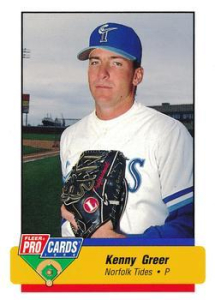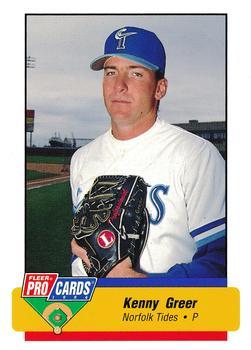September 29, 1993: From Greer to Eternity
 “Every kid dreams of pitching in the major leagues and I will never forget my debut.” — Kenny Greer, 20221
“Every kid dreams of pitching in the major leagues and I will never forget my debut.” — Kenny Greer, 20221
That statement is true of any rookie pitcher, but Kenny Greer’s first big-league game was especially memorable. Greer, a 26-year-old New York Mets righty in his sixth pro season, entered in the 17th inning of a scoreless game at Shea Stadium. After he retired the side in order, the deadlock was finally broken, giving Greer his only win in the majors.
The Mets won just 59 games in 1993. Excluding the strike-interrupted 1981 season, it was the fewest victories in a year for the franchise since 1965. Even during the lean years from 1977 through 1983, the Mets had not sunk so low.
It could have been worse except for a six-game winning streak to end the season. This story is about the second of those games, on Wednesday, September 29. It started at 7:40 P.M., and the weather was chilly, as was often true of Shea early and late in the season. The starter for the visiting St. Louis Cardinals, French-Canadian lefty Rhéal Cormier, was unfazed, thanks to his upbringing in a northern climate. Cormier was the only Cardinal not wearing a sweatshirt under his uniform.2
On the mound for the Mets was 23-year-old rookie right-hander Bobby Jones. Jones became the first Mets pitcher since David Cone on June 13, 1988, to start a game and go into the 10th inning.3 He was brilliant, striking out nine and allowing just four hits (though he did walk five). No Cardinal reached third base against him; only four got as far as second base. Shortstop Tim Jones led off the fourth with a bloop double. The Cards drew two two-out walks in the sixth. Third baseman Stan Royer hit a ground-rule double with one out in the seventh. In the 10th, Royer led off with a single and pinch-runner Lonnie Maclin was sacrificed to second. St. Louis wasted all those opportunities. Cardinals catcher Erik Pappas said, “We just didn’t get the hit when we needed it.”4
On the other hand, the Mets continued not to give Jones any offensive support. When he departed, the Mets had not scored a run for him in 34⅔ innings. “It’s the way it is,” Jones said. “It happens.”5
Cormier had been on the disabled list with shoulder irritation from mid-August through early September. Since returning, he’d had two strong outings and two so-so ones, but on this night he was in especially good form. He went seven innings and gave up just three hits and a walk—“he froze batters with his off-speed and fastball mix.” Pappas added, “He mixed up his pitches and didn’t make any mistakes.6 The best the Mets could do against him was a one-out double in the fifth by left fielder Darrin Jackson.
After Cormier departed, the Mets fared little better against the Cardinals bullpen. Paul Kilgus, Mike Pérez, Lee Guetterman, and Rob Murphy each pitched two scoreless innings. New York’s best opportunity came in the 13th. St. Louis committed a pair of errors to start the inning. Rookie pinch-hitter Tito Navarro attempted to bunt the runners over, but St. Louis put on the wheel play. Todd Zeile, who’d replaced Royer at third, fielded the bunt and threw to Tim Jones, who recorded the force out on lead runner Joe Orsulak.
Meanwhile, the Cardinals still couldn’t get on the board either. Jeff Innis, the righty with the low side-arm/semi-submarine delivery, went three innings. He was in a jam in the 13th when Zeile hit a leadoff double and Bernard Gilkey walked. Jones tried to sacrifice but his bunt was a poor one, back to Innis, who got the force at third. Gilkey reached third on an infield out, but Innis escaped when Mark Whiten struck out looking.
After Innis departed, Mauro “Goose” Gozzo came on and pitched three innings. In the 14th, second baseman Gerónimo Peña doubled with two outs but did not score. In the 16th, Gregg Jefferies led off by reaching on an error but was erased when Whiten—who was 0-for-7 in the game—hit into a double play. Cardinals manager Joe Torre felt that his hitters tried to do too much late in the game.7
Les Lancaster retired the side in order in the 16th after relieving Murphy. In the top of the 17th, Greer entered. The Boston native had come to the Mets in a September 17 trade with the New York Yankees.8 His season at Triple-A Columbus had ended on September 4, and he’d thought he was done for the year—he was summoned from home.9
Mets manager Dallas Green said, “I’d been saving [Greer] for a spot free of pressure. I guess the 17th inning of a scoreless game doesn’t have much pressure.”10
“I hadn’t pitched in a month,” said Greer. “I was trying to get pitches over the plate.”11
Yet he threw just four balls and 13 pitches altogether in a one-two-three inning. After Pappas lined to left, Peña and Lancaster struck out.
In the home half of the 17th, veteran first baseman Eddie Murray led off with a single. Dave Gallagher’s sacrifice advanced him to second. Joe Sexton of the New York Times called it “a rare moment of strategic competence for a pair of clubs that repeatedly failed to execute such routine plays.”12 Chico Walker fouled out, but Jeff Kent—0-for-6 to that point—doubled to bring Murray home. Sexton’s description deserves to be quoted in full:
“Kent hit a shot to center field. Ray Lankford, one of the fastest players in the National League, turned and ran for the fence. The baseball hung. Murray all but walked around third as he stared at Lankford. Manager Dallas Green was too exhausted to get up off the dugout bench to check. Lankford, tired or hopeless, had the double land over his head without raising his glove.
“Murray, enjoying the moment or underlining its absurdity, avoided home plate at first, and had to be shoved at it by Joe Orsulak. He touched it at last.”13
Greer’s remark echoed Sexton: “I think Jeff hit it too far. And maybe people were too tired to go get it.”14
The game had finally ended. It was just past midnight. The initial attendance—a surprisingly good 17,037—had dwindled to a couple of hundred diehards.15 Cardinals starter Cormier had gone back to the visitors’ hotel.16
Had play continued, the Mets had just one more relief pitcher available: Mike Maddux, who’d pitched the previous night.17 Injuries had ended the season earlier that month for three members of their bullpen: Josías Manzanillo, Anthony Young, and John Franco.18 Dallas Green might have considered using one of his starters, but the most likely choice—swingman Pete Schourek—had gone eight innings the night before. Green joked, “I think Joe Mac was going to pitch next.” He was referring to Mets general manager Joe McIlvaine, who’d been a minor-league hurler from 1969 through 1973. But Greer was ready to go further. “In high school, we played 17 innings. I pitched the last 12.”19
The last time the Mets had been in a scoreless game so long was August 19, 1968, when they lost 1-0 in 17 at Shea to the San Francisco Giants. (Earlier that year, on April 15 at Houston’s Astrodome, they’d lost 1-0 in 24 to the Astros.) The Cardinals had to go back to July 2, 1933: an 18-inning 1-0 loss to the Giants, then based in New York, at the Polo Grounds.20
Fellow Mets pitcher Eric Hillman offered a little gallows humor about the Mets’ dismal season. “He [Greer] just tied me and A.Y. for victories in 1993,” said Hillman, who was then 1-9.21 Young, whose record-setting 27-game losing streak had ended on July 28, was 1-16.
The Mets concluded their series sweep of the Cardinals the next night. They followed by sweeping the Florida Marlins on the road to finish the year. Even the brand-new expansion club managed to win 64 games in 1993, five more than New York.
Greer did not appear again that season. He spent one more stretch in the majors, consisting of eight games in long and middle relief for the San Francisco Giants in June and July 1995. His pro career ended when he declined an invitation to big-league camp in 1998 from the Arizona Diamondbacks.22
The lasting impact of Greer’s win was visible in Greg Prince’s 2009 book Faith and Fear in Flushing (subtitled “An Intense Personal History of the New York Mets”). The afterword, featuring Prince’s interview with longtime Mets broadcaster Gary Cohen, is called “From Greer to Eternity.”
Prince described how Cohen and WFAN radio partner Bob Murphy kept him “entranced the way only they could at the end of one of the worst years any baseball team has ever known.” Three years later, Prince got to chat with Cohen. Before Prince could finish setting up the description of Cohen and Murphy’s work that night, Cohen said, “You mean the Kenny Greer game?”23
Acknowledgments
This article was fact-checked by Bruce Slutsky and copy-edited by Len Levin.
Sources
In addition to the sources cited in the Notes, the author consulted Baseball-Reference.com and Retrosheet.org for pertinent information, including the box score and play-by-play.
https://www.baseball-reference.com/boxes/NYN/NYN199309290.shtml
https://www.retrosheet.org/boxesetc/1993/B09290NYN1993.htm
Notes
1 Kenny Greer, email to Rory Costello, February 28, 2022.
2 “Mets Slip By Cardinals 1-0 in 17 Innings,” St. Louis Post-Dispatch, September 30, 1993: 5D.
3 Joe Sexton, “And So, After 17 Innings, the Mets Finally Rest,” New York Times, September 30, 1993: B13.
4 “Mets Slip By Cardinals 1-0 in 17 Innings.”
5 Sexton.
6 “Mets Slip By Cardinals 1-0 in 17 Innings.”
7 “Mets Slip By Cardinals 1-0 in 17 Innings.”
8 That was one of the rare transactions between the two teams. The Yankees—then still in contention in the AL East race—acquired 40-year-old pitcher Frank Tanana. The lefty was finishing up his 21-year career in the majors.
9 Mark Herrmann, “Kent Double Ends Plenty of Nothing,” Newsday (Long Island, New York), September 30, 1993: 149.
10 Sexton.
11 Sexton.
12 Sexton.
13 Sexton.
14 Herrmann.
15 Herrmann.
16 “Mets Slip By Cardinals 1-0 in 17 Innings.”
17 Herrmann.
18 Manzanillo had hurt his knee fielding a grounder during Darryl Kile’s no-hitter on September 8. See Tom Friend, “Kile No-Hits Incredible Shrinking Mets,” New York Times, September 9, 1993: B13. Young had undergone season-ending surgery, first on his thumb, then on his elbow. See Joe Sexton, “Saberhagen Will Undergo Elbow Surgery,” New York Times, September 16, 1993: B13. Franco, who’d endured the worst season of his long career, had suffered a deep paper cut on his pitching thumb as he tried to put away a box of garbage outside his Staten Island home. “I had to or the raccoons would have got it,” Franco said. See Mal Florence, “Not Only That, but Aunt Bea sic and Opie Are Their Closers,” Los Angeles Times, September 29, 1993.
19 Herrmann.
20 Herrmann.
21 Sexton, “And So, After 17 Innings, the Mets Finally Rest.” Hillman got one more win that season; it came on September 30.
22 Kenny Greer, email to Rory Costello, May 21, 2021.
23 Greg W. Prince, Faith and Fear in Flushing (New York: Skyhorse Publishing, 2009), 287.
Additional Stats
New York Mets 1
St. Louis Cardinals 0
17 innings
Shea Stadium
New York, NY
Box Score + PBP:
Corrections? Additions?
If you can help us improve this game story, contact us.


